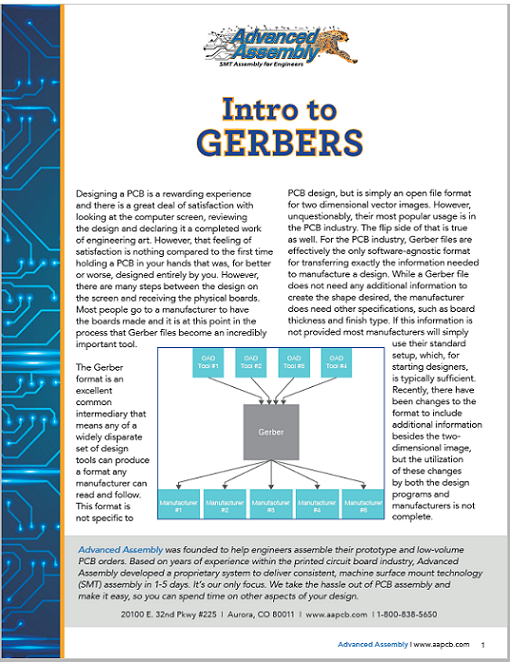
Gerber files are designed to contain all of the information necessary to create a printed circuit board. It is important not only to understand their general purpose, but also the details of what they contain. For those less familiar, Gerber files have certain terminology associated with them that may be confusing. Once the information and terms are fully understood, designers will be completely equipped to use them properly and convey exactly what they need. The data typically found in the Gerber files includes the following:
Board outline
Copper for each layer of the board – each layer in a separate file Soldermask info for top and bottom – where soldermask should not be placed Silkscreen info for top and bottom – again in separate files Solder paste application areas – for stencil creation Milling information – for cutouts inside the PCB outline Drill holes – frequently created as an Excellon rather than a Gerber While Gerbers are the undisputed leader in the PCB manufacturing format, they’re not the only choice. Other than the RS-274X standard, there’s the older RS-274-D standard, ODB++ and DPF formats. Certain manufacturers can even accept the design files from specific design suites, such as Altium or Eagle. To maximize compatibility and to ensure the layers represent everything desired, RS-274X format is highly recommended. For drill data, Excellon is the market standard, though many experts recommend using the Gerber format even for drill holes to reduce the risk of alignment problems.
Although Gerbers contain all the shape and size information needed for each layer of a PCB, it is still essential to provide additional information as a readme file. This information includes:
Laminate material required, typically a form of FR-4 Thickness of board Plating on all, some or none of the holes Tolerances required for the holes Panelizing information and data about depth of scoring Naming convention of the included Gerber files Finish type Copper weight Soldermask / Silk screen color Special requirements such as impedance matching It is imperative to share these requirements with your PCB manufacturer, otherwise standard PCB specifications may be used.
Recommendations
While generating and reviewing the Gerber files, there are a couple recommendations that you should probably follow to make sure that the data is being conveyed properly.
Use the same units and grids in all aspects of your project. If you’re using metric or Imperial for one portion of your project, maintain it throughout the process, including the settings of your Gerber generator and Excellon generator.
Follow a standard naming convention or see if there is a preferred naming convention for your particular fabricator.
Intuitively understand what your board looks like from the file viewer. Everything on the bottom of the board should be mirrored as if you were looking through the board. If it’s on the bottom side of the board and it’s readable, it’s probably wrong. If it’s on the top and unreadable, it’s probably wrong.
Include the board outline on every layer of the Gerber – this will help with alignment and registration problems if they occur To make the manufacturer’s life a bit easier, verify that your pads are flashed where possible. Flashing pads means that the pads are made up of a single, simple polygon in the file instead of being drawn by many little lines. Flashing the pads makes file sizes significantly smaller and easier to work with. This can be controlled via settings in your PCB design tool.
Avoid offsets and scaling. Besides adding complexity and a greater chance of failure, they are rarely needed in most PCB manufacturing.
Look at your files. This cannot be stressed enough. Never trust a Gerber generator to provide exactly what is expected. They will nearly always work perfectly, but if they don’t and it is not caught, there will be a lot of time and money wasted accompanied by many questions. While good manufacturers will review the data, they won’t be able to catch everything and No-Touch Services specifically will not review what is sent. If there is any bad or corrupted information sent to the PCB manufacturer the final responsibility for this error, and potentially large quantities of money, lies with whoever sent the data.
With a good understanding of Gerbers, and by using these tips and tricks, designers and engineers can confidently submit files knowing what they receive is exactly what they requested.
Advertisement
Learn more about Advanced Assembly





